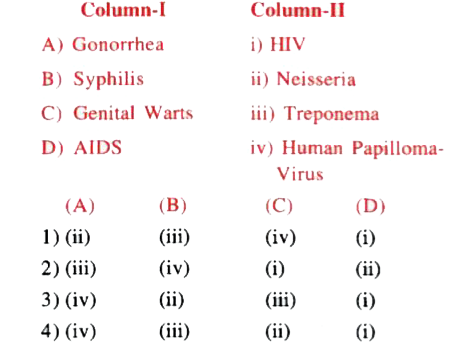Dicot leaf shows differential colouration between the two surfaces because of
Undifferentiated mesophyll
Presence of upper palisade and lower spongy parenchyma
Presence of upper spongy and lower palisade parenchyma
Presence of spongy parenchyma only
The correct Answer is:B
To answer the question "Dicot leaf shows differential coloration between the two surfaces because of", we will analyze the options based on the structure of a dicot leaf and the arrangement of its tissues.
1. Understanding Leaf Structure:
- A dicot leaf typically has two distinct surfaces: the upper surface (adaxial) and the lower surface (abaxial).
- The leaf is composed of various types of tissues, including epidermis, mesophyll (which includes palisade and spongy parenchyma), and vascular tissues.
2. Identifying Mesophyll Types:
- The mesophyll is divided into two main types:
- Palisade Parenchyma: Located just beneath the upper epidermis, these cells are elongated and tightly packed. They contain a high concentration of chlorophyll, making this region appear darker green.
- Spongy Parenchyma: Found beneath the palisade layer, these cells are loosely arranged with air spaces. They contain fewer chlorophylls, resulting in a lighter green coloration.
3. Differential Coloration:
- The differential coloration between the two surfaces of the leaf is primarily due to the presence of these two types of mesophyll.
- The adaxial surface (upper side) has a higher concentration of chlorophyll due to the palisade parenchyma, making it appear darker green.
- The abaxial surface (lower side) has the spongy parenchyma, which has a lower chlorophyll concentration, leading to a lighter green color.
4. Effects of Sunlight Exposure:
- The adaxial surface is more exposed to sunlight, which enhances chlorophyll production in the palisade parenchyma. This contributes to the darker green coloration of the upper surface.
- Conversely, the abaxial surface is less exposed to direct sunlight, resulting in a comparatively lighter coloration.
5. Conclusion:
- The differential coloration between the two surfaces of the dicot leaf is due to the presence of the upper palisade and lower spongy parenchyma.
Final Answer:
The correct option is: presence of upper palisade and lower spongy parenchyma.
- A dicot leaf typically has two distinct surfaces: the upper surface (adaxial) and the lower surface (abaxial).
- The leaf is composed of various types of tissues, including epidermis, mesophyll (which includes palisade and spongy parenchyma), and vascular tissues.
- The mesophyll is divided into two main types:
- Palisade Parenchyma: Located just beneath the upper epidermis, these cells are elongated and tightly packed. They contain a high concentration of chlorophyll, making this region appear darker green.
- Spongy Parenchyma: Found beneath the palisade layer, these cells are loosely arranged with air spaces. They contain fewer chlorophylls, resulting in a lighter green coloration.
- The differential coloration between the two surfaces of the leaf is primarily due to the presence of these two types of mesophyll.
- The adaxial surface (upper side) has a higher concentration of chlorophyll due to the palisade parenchyma, making it appear darker green.
- The abaxial surface (lower side) has the spongy parenchyma, which has a lower chlorophyll concentration, leading to a lighter green color.
- The adaxial surface is more exposed to sunlight, which enhances chlorophyll production in the palisade parenchyma. This contributes to the darker green coloration of the upper surface.
- Conversely, the abaxial surface is less exposed to direct sunlight, resulting in a comparatively lighter coloration.
- The differential coloration between the two surfaces of the dicot leaf is due to the presence of the upper palisade and lower spongy parenchyma.
The correct option is: presence of upper palisade and lower spongy parenchyma.
Topper's Solved these Questions
- HISTOLOGY AND ANATOMY OF FLOWERING PLANTSBook:AAKASH SERIESChapter:HISTOLOGY AND ANATOMY OF FLOWERING PLANTSExercise:EXERCISE - I (SECONDARY GROWTH)
Explore 45 Videos
- HISTOLOGY AND ANATOMY OF FLOWERING PLANTSBook:AAKASH SERIESChapter:HISTOLOGY AND ANATOMY OF FLOWERING PLANTSExercise:EXERCISE - II
Explore 214 Videos
- HISTOLOGY AND ANATOMY OF FLOWERING PLANTSBook:AAKASH SERIESChapter:HISTOLOGY AND ANATOMY OF FLOWERING PLANTSExercise:EXERCISE - I (THE TISSUES SYSTEMS)
Explore 41 Videos
- ENVIRONMENTAL ISSUESBook:AAKASH SERIESChapter:ENVIRONMENTAL ISSUESExercise:Exercise-III (Previous AIPMT/NEET Questions)
Explore 41 Videos
- HUMAN HEALTH DISEASEBook:AAKASH SERIESChapter:HUMAN HEALTH DISEASEExercise:EXERCISE - III (PREVIOUS AIPMT/NEET QUESTIONS)
Explore 56 Videos
Similar Questions
Dedifferentiation occurs during the formation of
View SolutionHistogen theory was proposed by
View SolutionGuard cells of stomata are very closely associated with
View SolutionWhich of the following in sewage treatment removes suspended solids?
View SolutionMatch the following sexually transmitted diseases (Colum-I) with their causative agent (Column -II) and select the correct option.

View Solutionwhat differentiates a dicot leaf from monocot leaf
View Solutionसरल पत्ती एवं संयुक्त पत्ती में अन्तर बताइए ।
View SolutionMesophyll of dicot leaf is differentiated into ________ and ________ parench y ma.
View SolutionDifferentiate Dicot leaf and Monocot leaf.
View SolutionDifferentiate the features of Monocot and Dicot leaf.
View SolutionWrite any three anatomical differences between dicot leaf and monocot leaf.
View SolutionDicot leaf is isobilateral leaf
View SolutionDicot leaf shows differential colouration between the two surfaces because of
View SolutionDifferentiate between dicot stem and dicot root.
View SolutionDifferentiate between monocots and dicots.
View SolutionDifferentiate between Simple leaf and Compound leaf.
View Solution
